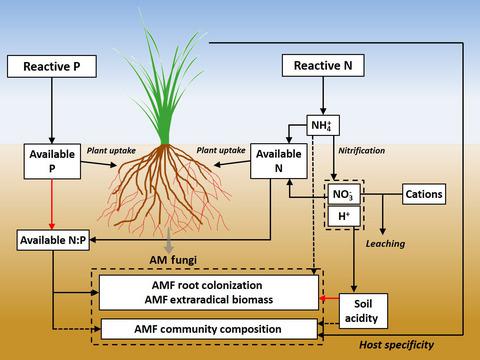当前位置:
X-MOL 学术
›
Glob. Change Biol.
›
论文详情
Our official English website, www.x-mol.net, welcomes your feedback! (Note: you will need to create a separate account there.)
Nitrogen‐induced acidification, not N‐nutrient, dominates suppressive N effects on arbuscular mycorrhizal fungi
Global Change Biology ( IF 11.6 ) Pub Date : 2020-08-15 , DOI: 10.1111/gcb.15311 Shang Pan 1 , Yang Wang 2 , Yunpeng Qiu 1 , Dima Chen 2, 3 , Lin Zhang 1 , Chenglong Ye 1 , Hui Guo 1 , Weixing Zhu 4 , Aiqun Chen 5 , Guohua Xu 5, 6 , Yi Zhang 1 , Yongfei Bai 2 , Shuijin Hu 1, 7
Global Change Biology ( IF 11.6 ) Pub Date : 2020-08-15 , DOI: 10.1111/gcb.15311 Shang Pan 1 , Yang Wang 2 , Yunpeng Qiu 1 , Dima Chen 2, 3 , Lin Zhang 1 , Chenglong Ye 1 , Hui Guo 1 , Weixing Zhu 4 , Aiqun Chen 5 , Guohua Xu 5, 6 , Yi Zhang 1 , Yongfei Bai 2 , Shuijin Hu 1, 7
Affiliation

|
Arbuscular mycorrhizal fungi (AMF) form symbiosis with most terrestrial plant roots, obtaining photosynthates in return for mineral nutrients. Ecological theories based on the economics of trading partnership predict that nutrient enrichment would suppress AMF. Experimental results from nitrogen (N) and phosphorus (P) additions, however, were highly variable, and the underlying mechanisms remain unclear. Here we show distinct AMF responses to soil N:P stoichiometry manipulations via gradients of long‐term N and P additions in a Mongolian steppe. A complementary experiment with an acid addition gradient was designed to help tease apart the effect of N‐induced acidification from N nutrient. AMF root colonization and extraradical fungal biomass progressively decreased along the P gradient under two distinct host plant species, suggesting a carbon (C)‐P tradeoff. In contrast, low to moderate N inputs increased both AMF parameters, corresponding to the increasing N:P ratio. Yet, high N inputs reduced AMF colonization and biomass, and the magnitudes of N‐led inhibition were similar to those under acid additions that induced comparable changes in soil pH. Structural equation modeling further showed that while soil N:P stoichiometry primarily controlled the effect of P addition on AMF, N‐induced soil acidity overtook the N:P stoichiometry under high N inputs and dominated the effects of reactive N on AMF. In addition, AMF community composition in roots was more dependent on host plants and unresponsive to changes in soil nutrients. We further proposed a comprehensive framework that integrates biological and geochemical effects of reactive N and P inputs on AMF. Together, these results indicate that while the C‐P tradeoff controls P suppression of AMF, N‐induced acidification dominates the N inhibition. Our findings suggest that incorporation of geochemical impacts of N and P inputs would facilitate modeling efforts to project mycorrhizal impact on plant interactions and soil C balance under future nutrient enrichment scenarios.
中文翻译:

氮诱导的酸化而不是氮营养,主要是控制氮对丛枝菌根真菌的抑制作用
丛枝菌根真菌(AMF)与大多数陆生植物根形成共生关系,获得光合产物以换取矿物质营养。基于贸易伙伴关系经济学的生态理论预测,营养丰富会抑制AMF。但是,添加氮(N)和磷(P)的实验结果变化很大,其潜在机理仍不清楚。在这里,我们通过蒙古草原中长期施用N和P的梯度,显示了对土壤N:P化学计量操作的不同AMF反应。设计了具有添加酸梯度的补充实验,以帮助从氮养分中分离出氮诱导的酸化作用。在两种不同的寄主植物物种下,AMF根定殖和自由基外生物量沿P梯度逐渐降低,建议碳(C)-P权衡。相反,低至中等的N输入会增加两个AMF参数,这对应于N:P比率的增加。然而,高氮输入减少了AMF的定殖和生物量,并且N诱导的抑制作用的程度与添加酸引起土壤pH值发生可比变化的抑制作用相似。结构方程模型进一步表明,尽管土壤氮磷化学计量主要控制磷的添加对AMF的影响,但在高氮输入下,氮诱导的土壤酸度超过了氮磷化学计量,并控制了活性氮对AMF的影响。此外,根部的AMF群落组成更依赖寄主植物,对土壤养分的变化无反应。我们进一步提出了一个综合框架,该框架整合了活性N和P输入对AMF的生物和地球化学作用。一起,这些结果表明,尽管C–P折衷控制了AMF的P抑制,但N诱导的酸化作用主要是N抑制。我们的研究结果表明,将氮和磷输入物的地球化学影响结合起来,将有助于在未来养分丰富的情况下模拟菌根对植物相互作用和土壤碳平衡的影响。
更新日期:2020-10-19
中文翻译:

氮诱导的酸化而不是氮营养,主要是控制氮对丛枝菌根真菌的抑制作用
丛枝菌根真菌(AMF)与大多数陆生植物根形成共生关系,获得光合产物以换取矿物质营养。基于贸易伙伴关系经济学的生态理论预测,营养丰富会抑制AMF。但是,添加氮(N)和磷(P)的实验结果变化很大,其潜在机理仍不清楚。在这里,我们通过蒙古草原中长期施用N和P的梯度,显示了对土壤N:P化学计量操作的不同AMF反应。设计了具有添加酸梯度的补充实验,以帮助从氮养分中分离出氮诱导的酸化作用。在两种不同的寄主植物物种下,AMF根定殖和自由基外生物量沿P梯度逐渐降低,建议碳(C)-P权衡。相反,低至中等的N输入会增加两个AMF参数,这对应于N:P比率的增加。然而,高氮输入减少了AMF的定殖和生物量,并且N诱导的抑制作用的程度与添加酸引起土壤pH值发生可比变化的抑制作用相似。结构方程模型进一步表明,尽管土壤氮磷化学计量主要控制磷的添加对AMF的影响,但在高氮输入下,氮诱导的土壤酸度超过了氮磷化学计量,并控制了活性氮对AMF的影响。此外,根部的AMF群落组成更依赖寄主植物,对土壤养分的变化无反应。我们进一步提出了一个综合框架,该框架整合了活性N和P输入对AMF的生物和地球化学作用。一起,这些结果表明,尽管C–P折衷控制了AMF的P抑制,但N诱导的酸化作用主要是N抑制。我们的研究结果表明,将氮和磷输入物的地球化学影响结合起来,将有助于在未来养分丰富的情况下模拟菌根对植物相互作用和土壤碳平衡的影响。



























 京公网安备 11010802027423号
京公网安备 11010802027423号